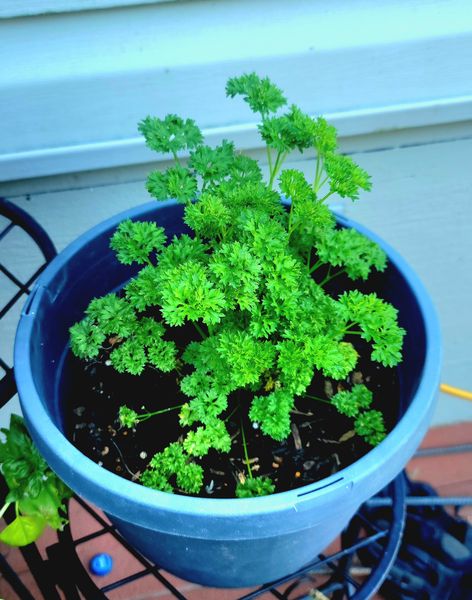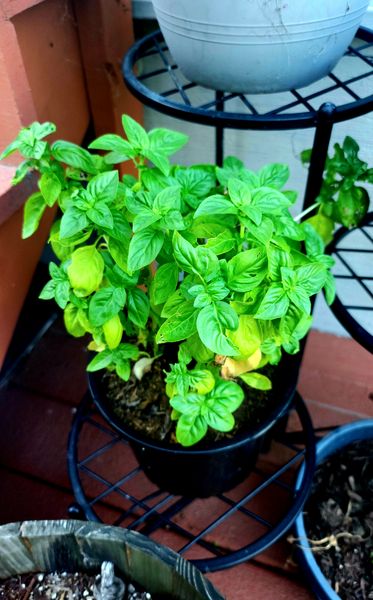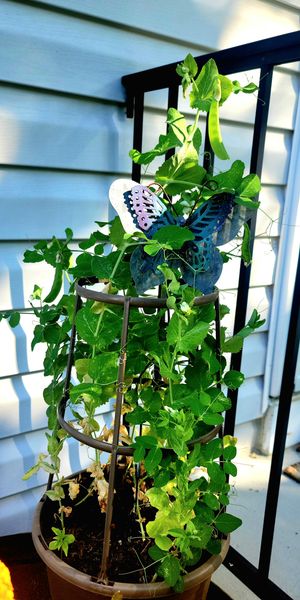4 Steps to Create Your First Container Garden
This page may contain affiliate links

Planting in containers is a great way to garden in small spaces, bring greenery into your home or even put a few kitchen herbs into your cooking space. There are so many great ways to garden using containers! You can use a purchased pot from the store, hand me downs from others or even re-purpose a container from around the house. We love using terracotta pots and coffee canisters that we paint and fill with potting soil! You really can use almost anything! (We love this set of Terracotta pots!) So let’s take a look at what it takes to create your first container garden!
Step 1: Find your location(s)
There are a few things you want to think about when choosing where to plant inside. Sunlight, obstacles in the home and a water source. Sunlight is the top variable that I think about. Will your plant need a full day of sunlight, or just a few hours each day? If you are choosing to grow veggies in containers, they usually need about 6-8 hours of direct sunlight each day. Many veggies do great on a patio or porch, but make sure they will see the light! I use a free compass app on my phone to make sure that my light needy plants are facing south. This will ensure they are getting the most sun possible. Herbs also need a bit of light and work best with at least 6 hours of light. We grow indoor herbs under grow lamps that help me to regulate how much light ours get. (Click here for a great starter system). Houseplants are ones that vary and can do with almost no sunlight up to 18 hours. When you are plant shopping the tag will help you with those needs and I usually choose to pick a plant that needs fewer hours. Always ask if you are unsure. I spend so much time tending to my plants that grow veggies and herbs, that I don’t want to mess with greenery in my living room, but still appreciate it’s beauty and ability to bring the outdoors inside. You can have the best of both worlds, just don’t overdo it.
Remember to think about what obstacles you have in the home. We have 2 large dogs that could easily knock over low sitting plants or even sniff them to death. It’s funny, but not funny when there is potting soil all over the floor. I am also pretty klutzy, so I try to choose places near windows and a bit higher up than where I normally work or walk. In my home I keep succulents on shelves and in the bathrooms. Succulents are great to capture the moisture created from your shower! I have a few houseplants in the living room on our media table and on a shelf above our bay window. I have three indoor hydroponic systems that grow herbs, lettuces and even some veggies that I can’t grow outdoors in the winter like cherry tomatoes and jalapenos. (Click here for my ideal starter garden). Finally, I have smaller pots on my window sill above the sink that hold seed starts and plants that require a lot of water like cilantro! Speaking of water, that is something else that is important to think about. I usually just fill a tall cup with water and walk around the house once or twice a week to water the plants, but are you willing to do that? I keep extra thirsty plants on my sink window sill to simply pull to the faucet as needed and take very little thought.
These three factors are what I think about when finding a location for plants and helps me to choose the right plant for that location. Where will you start?

Step 2: Choose your plants
The next step is to decide which plants to grow. This is where you can get creative! Will you grow veggies or herbs, flowers or houseplants? First thing to think about is: how many hours of light does your plant location get. Remember those requirements we talked about above? They matter. I prefer houseplants to filter the air, succulents to absorb moisture and veggies & herbs to eat! Each plant in my home serves a purpose, but also looks great. I love the feeling I get when we bring outdoor features inside our home. Especially throughout the winter when our time outdoors is minimized compared to all day in the summer.

Step 3: Get your container ready
Getting your container ready is what will help your new plant succeed. These steps are especially important if you are making your own pot, or re-purposing another item like a coffee canister or watering can. Make sure that your container has drainage holes at the bottom. This will help from the soil storing too much water that can cause mold or rot. I like to place a reservoir under my containers to hold water that my plant can drink when it is thirsty. (Terracotta saucers are inexpensive and a great reservoir.) This set of containers comes with a built in reservoir to make life even easier! https://amzn.to/3JKrmG0 For larger pots I put rocks, stones or marbles at the bottom, but smaller pots do not necessarily need this. I wouldn’t worry about this step to get started, but as you grow it is something to think about. I use my own potting mix when I have the time to make it, but this potting mix works great and is easy to pick up: https://amzn.to/3vKbxJG. Remember to think about the roots of your plant. If you are planting a radish, it will grow down and prefers a wider space. If you are planting cilantro, it will not need a deep wide space, but will need lots of water and light. What you decided to plant will help determine the size and shape of your container, as well as how much soil is needed. Have questions? Don’t hesitate to reach out in the comments or on social media and I’ll help you out!
Step 4: Plant your garden
Now for the fun part! Plant your new plants or seeds in your containers! Remember to water down your soil well to start your plants and then follow your new watering schedule after. The initial water will help your new plant settle and set up the container for success. Remember to water your plants regularly and monitor leaves. It is now time to sit back and appreciate what you are growing and what you have done. You did that! It is fulfilling and so much fun to grow your own plants, veggies and more!
Helpful Hint:
With so many options for containers and plants, my best advice is to start small and keep it as simple as possible. Think about what your purpose is. Are you looking to bring some natural greens into your living room? Start with a small houseplant that looks great on the media console and doesn’t need a lot of light. Looking to start growing some herbs? Pick one or two herbs to start with in small pots on the window sill. Don’t overthink it and start with a simple item to begin. I have often planted too much and quickly was overwhelmed. It is better and much more fulfilling when you start small and grow as your garden will over time!
Let us know what you plan to start growing in and around your home! We can’t wait to hear about your growing adventure. Let’s get started growing your first container garden!
